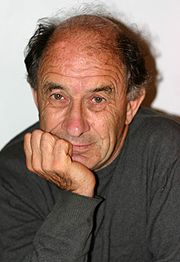nLab Vladimir Arnold

Владимир Игоревич Арнольд (Vladimir Igorevich Arnol’d) was a Russian mathematician and mathematical physicist, working in Moscow and Paris.
-
B. Khesin & S. Tabachnikov: Vladimir Igorevich Arnold. 12 June 1937 - 3 June 2010, Biogr. Mems Fell. R. Soc. 64 (2018) 7–26 [doi:10.1098/rsbm.2017.0016, pdf]
-
biography at MacTutor history of math archive
Selected writings
On the real cohomology of configuration spaces of points:
- Vladimir Arnold, The cohomology ring of the colored braid group, Mat. Zametki, 1969, Volume 5, Issue 2, Pages 227–231 (mathnet:mz6827)
On classical Hamiltonian mechanics formulated via symplectic geometry (ie. with phase space understood as a symplectic manifold):
- Vladimir Arnol'd, Mathematical methods of classical mechanics, Graduate Texts in Mathematics 60, Springer (1978) [doi:10.1007/978-1-4757-1693-1]
The Arnold-Kuiper-Massey theorem:
-
Vladimir Arnold, Ramified covering , hyperbolicity and projective topology, Siberian Math. Journal 1988, V. 29, N 5, P.36-47
-
Vladimir Arnold, On disposition of ovals of real plane algebraic curves, involutions of four-dimensional manifolds and arithmetics of integer quadratic forms, Funct. Anal. and Its Appl., 1971, V. 5, N 3, P. 1-9.
On methods of topology and homotopy theory in hydrodynamics:
- Vladimir Arnold, Boris Khesin, Topological methods in hydrodynamics, Applied Mathematical Sciences 125, Springer 1998 (doi:10.1007/b97593)
On mathematics and its relation to physics:
-
Vladimir I. Arnold, Will mathematics survive? Report on the Zurich Congress, The Mathematical Intelligencer 17 (1995) 6–10 [doi:10.1007/BF03024363]
“At the beginning of this century a self-destructive democratic principle was advanced in mathematics [which] led mathematicians to break from physics and to separate from all other sciences. In the eyes of all normal people, they were transformed into a sinister priestly caste of a dying religion, like Druids, parasitic on science and technology, recruiting acolytes in the mathematical schools by Zombie-like mental subjection. Bizarre questions like Fermat's problem or problems on sums of prime numbers were elevated to supposedly central problems of mathematics.”
-
Vladimir I. Arnold, On teaching mathematics, Russ. Math. Surv. 53 1 (1998) 229 [doi:10.1070/RM1998v053n01ABEH000005, web]
“Mathematics is a part of physics. Physics is an experimental science, a part of natural science. Mathematics is the part of physics where experiments are cheap.
The Jacobi identity (which forces the altitudes of a triangle to meet in a point) is an experimental fact in the same way as the fact that the earth is round (that is, homeomorphic to a ball). But it can be discovered with less expense.
In the middle of the twentieth century an attempt was made to separate physics and mathematics. The consequences turned out to be catastrophic. Whole generations of mathematicians grew up without knowing half of their science and, of course, in total ignorance of any other sciences. They first began teaching their ugly scholastic pseudo-mathematics to their students, then to schoolchildren (forgetting Hardy’s warning that ugly mathematics has no permanent place under the sun).
Since scholastic mathematics that is cut off from physics is fit neither for teaching nor for application in any other science, the result was a universal hatred of mathematicians, both on the part of the poor schoolchildren (some of whom in the meantime became ministers) and of the users.
[…]
A teacher of mathematics who has not got to grips with at least some of the volumes of the course by Landau and Lifshitz will then become a relic like the person nowadays who does not know the difference between an open and a closed set.“
-
Vladimir I. Arnold, Polymathematics: Is mathematics a single science or a set of arts?, in: V. Arnold, P. Lax, B. Mazur (eds.), Mathematics: Frontiers and Perspectives, AMS (2000) 403-416 [ISBN: 978-0-8218-2697-3, pdf]
“All mathematics is divided into three parts: cryptography (paid for by CIA, KGB and the like), hydrodynamics (supported by manufacturers of atomic submarines) and celestial mechanics (financed by military and other institutions dealing with missiles, such as NASA).
Cryptography has generated number theory, algebraic geometry over finite fields, algebra“, combinatorics and computers.
Hydrodynamics procreated complex analysis, partial differential equations, Lie groups and algebra theory, cohomology theory and scientific computing.
Celestial mechanics is the origin of dynamical systems, linear algebra, topology, variational calculus and symplectic geometry.
The existence and mysterious relations between all these different domains is the most striking and delightful feature of mathematics (having no rational explanation).“
[…]
“Hilbert tried to predict the future development of mathematics and to influence it by his Problems. The development of mathematics in the 20th century has followed a different path. The most important achievements – the flourishing of homotopy theory and of differential topology, the geometrisation of all branches of mathematics, its fusion with theoretical physics, the discovery of the algorithmically undecidable problems and the appearance of computers – all this went in a different (if not opposite) direction.
The influence of H. Poincaré and of H. Weyl on the science of the 20th century was much deeper. To Poincaré, who created modern mathematics, topology and dynamical systems theory, the future of mathematics lay in the development of mathematical physics, oriented to the description of the relativistic and quantum phenomena.“
[…]
Related entries
Last revised on July 10, 2023 at 15:13:52. See the history of this page for a list of all contributions to it.